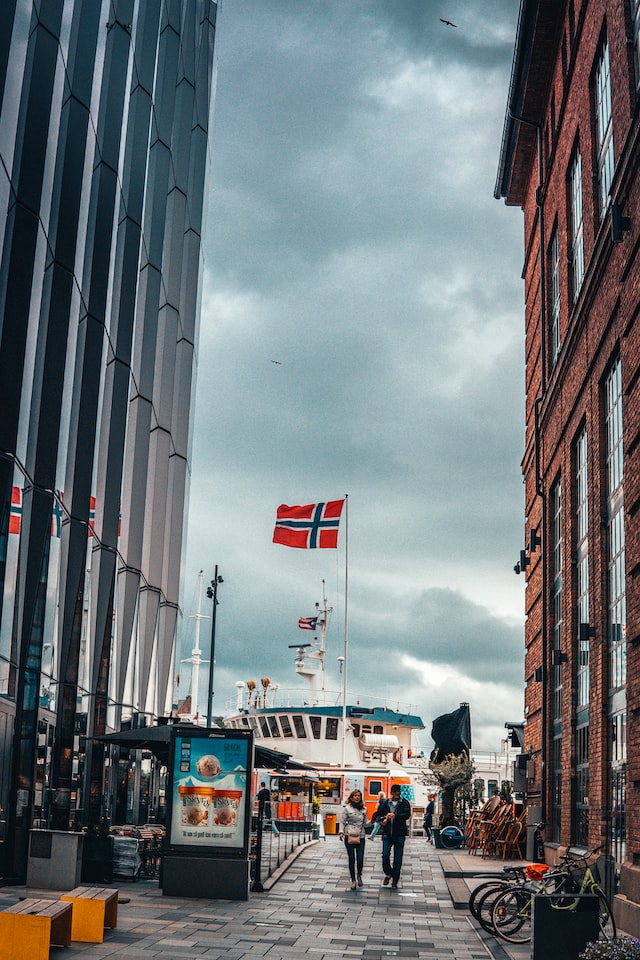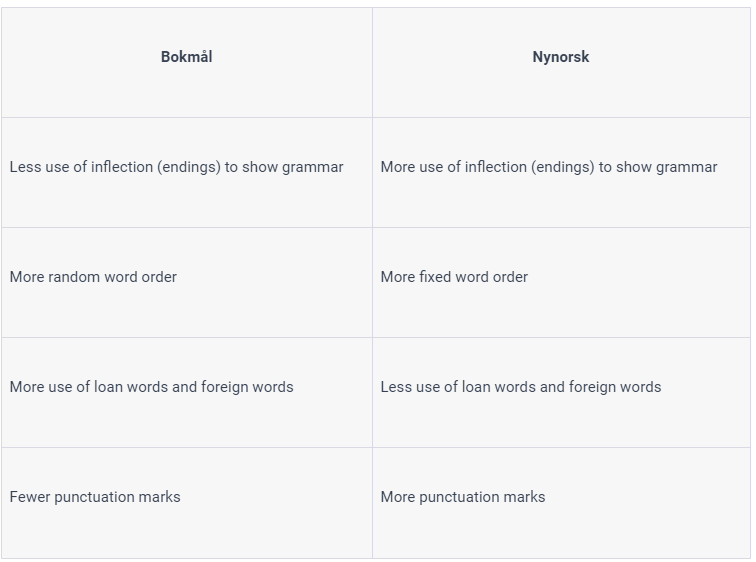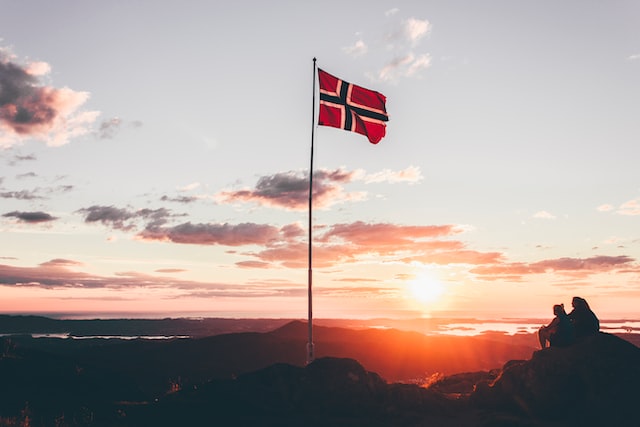
Which Norwegian dialect should I learn? Bokmål VS Nynorsk
Though Norway is a relatively small country, we still have two official languages, and a whole lot more spoken dialects. A natural question any aspiring Norwegian learner will want to ask themselves then is which dialect they should learn.

Key takeaways
- The difference between bokmål and nynorsk is not necessarily the same as differences between dialects.
- Bokmål is by far the more common of the two official written languages in Norway.
- Choosing to learn a dialect that closely matches bokmål will make the learning process easier.
- Exposing yourself to other dialects through conversation is an important step towards fluency.
What type of Norwegian should I learn?
The most common form of Norwegian is bokmål. That is the short and sweet answer to this very common question asked by anyone deciding to learn Norwegian. Though we have two official languages in Norway, bokmål and nynorsk, bokmål is the more common one.
However, both of these forms of Norwegian are written languages only. And if you’ve ever been to Norway or spoken to a Norwegian, you quickly find out that there are many more dialects within the country.
Though these dialects base themselves off of either bokmål or nynorsk, these dialects vary greatly, to the point where even some Norwegians have a hard time understanding what other Norwegians are saying from time to time, as this study shows.
What does this mean for you?
For a learner this means your first step in learning Norwegian should most likely be to learn bokmål.
This of course varies based on a lot of factors.
- Where you live.
- Understanding whether the dialect spoken in the city you live in is based on bokmål or nynorsk will help you choose which form to focus on.
- What your goal is.
- Do you want to learn the language simply as a hobby? Go for bokmål.
- Are you learning for a specific purpose, like work or moving to a new city? Find out what dialect is spoken and whether it more closely resembles bokmål or nynorsk.
- Resources available.
- Since bokmål is the more standardized of the two, you’ll probably find way more learning materials teaching this form. Therefore choosing to learn bokmål as opposed to nynorsk will give you a great well of resources to draw upon.
All these factors aside, becoming fluent in Norwegian means you will need to familiarize yourself with both bokmål and nynorsk, and have conversations with people with all types of dialects. That is why we in Norwegian Community believe in language learning through natural conversation with others.
What is the difference between Norwegian Bokmål and Nynorsk?
In short, the difference between bokmål and nynorsk lies in their writings. Understanding the differences between them requires a short trip through history though. Let’s take a brief look here.
- History with Denmark:
- Norway was once under Danish rule, with Danish being the official language. When we became independent in 1814, we had some choices to make in regards to the language we would speak going forward.
- Should we keep Danish as the official language? (Spoiler alert: NO!)
- Should we compile the various dialects spoken throughout the country into a new official language?
- Should we Norwegianize the Danish language we had grown used to after over 400 years under Denmark.
- The first idea was scrapped pretty much immediately. The second idea became nynorsk, thanks to the works of Ivar Aasen. And the third idea became what we now refer to as bokmål.
- Norway was once under Danish rule, with Danish being the official language. When we became independent in 1814, we had some choices to make in regards to the language we would speak going forward.
- Geography:
- Bokmål is most commonly used in the South East and North of Norway.
- Nynorsk is more common in the South West.
- You will also encounter a stronger presence of nynorsk the more rural area you find yourself in.
- Grammar:
There are A LOT of differences in grammar between bokmål and nynorsk, this is why school children spend years of their education learning the difference. Here are some of the most important differences:

Take a look at some examples:
- Bokmål: Jeg har en bok
- Nynorsk: Eg har ei bok
- Bokmål: Vi skal til byen
- Nynorsk: Vi skal til bygda
- Bokmål: Hun spiser maten sin
- Nynorsk: Ho spider maten hennes
Learn fluent Norwegian in 4 months. Start today.
Did you know that you don’t need all the grammar to speak fluent Norwegian? In our classes we focus just on the necessary vocabulary. So you can learn 3 times faster.
Which language is most spoken in Norway?
We’ve already touched on how bokmål is the more common form of Norwegian. But as stated, it is technically a written language, and the dialects spoken vary greatly.
However, bokmål is also used as a spoken language. You’ll encounter Norwegians who speak exactly the same way as bokmål is written in several parts of the country. Though intinations and some changes will vary from dialect to dialect, you can rest assured that bokmål is more spoken than nynorsk.
In fact, 85-90% of Norwegians write in bokmål, and as such, it is natural for this form of Norwegian to make its way into the spoken dialect. You will more commonly find this to be the case in the South East of the country, where the capital, Oslo, resides.
What does this mean for me?
So for you, the aspiring Norwegian speaker, this means that the overwhelming majority of texts you will encounter in Norwegian will be in bokmål. You can then either make it easy on yourself and speak the same as what you read, or you can complicate matters a bit and learn to speak and write nynorsk and read bokmål. Seems like a simple choice really…
But this is not to take away from nynorsk. Nynorsk has a vast and rich history in Norway, and is as essential a part of the history and culture as anything else. This is the reason school children in Norway are required to learn it in school.
What is the standard Norwegian dialect?
There is no standard Norwegian dialect. Norwegians are often very proud of the history and heritage of the area where they hail from. And as such, their dialect is many times a point of pride.
Turn on the TV. Whether you’re watching the news, scripted television, reality TV or anything in between, you will encounter all types of dialects. This is just a part of the Norwegian way of life.
The same applies to major cities where people move to either for studies or work. People will often hold on to their dialects even though they might be surrounded by people who speak in other dialects. It is really quite beautiful to have so much variety within such a small country.
Even schools encourage this variety. Students are free to speak in the dialect of their choosing, and this right is even protected under law. Of course the majority of children will share the same dialect, but it is not uncommon for a few children to have a different dialect than their classmates and fit in without problems.
So since there is no standard dialect in Norway, which one should you learn?
That is completely up to you! Hurray! As stated before, some dialects will more closely resemble the more common written form of Norwegian, bokmål. And therefore these might appear easier to learn.
But exposing yourself to different dialects and becoming more familiar with the differences between them will make you a more well rounded speaker. This is something you can only do through conversations with others who speak this dialect.
Our lessons do just that. You’ll learn from speakers from all parts of the country, and though we tend to teach in bokmål, our dialects make appearances throughout our lessons. In this way you won’t be completely unfamiliar when you’re presented with a new dialect.

Learn fluent Norwegian from your level
Check your level now, and find the right course for you
Our classes has native Norwegians who knows how it feels to learn a language, and will do everything to help you.
How many dialects are there?
Depending on who you ask, there are 4 to 6 main dialects in Norwegian. But there are a lot more that fall under these main umbrellas. Around 50 to be exact!
The main ones are:
- Nordnorsk.
- You’ll find this in Northern Norway.
- Bodø and Alta dialect are examples of this.
- You’ll find this in Northern Norway.
- Trøndersk.
- You’ll find this in Central to Northern Norway .
- Trondheim dialect for example.
- You’ll find this in Central to Northern Norway .
- Vestlandsk.
- You’ll find this to the West.
- Bergen and Stavanger dialects are examples.
- You’ll find this to the West.
- Østlandsk.
- From Eastern Norway.
- Oslo and Fredrikstad dialects for example.
- From Eastern Norway.
- Midlandsmål.
- Central Norway.
- Bø dialect for example.
- Central Norway.
- Sørlandsk.
- Southern Norway.
- Arendal and Kristiansand dialects.
- Southern Norway.

Where should a new learner even get started? Well, as we’ve established, bokmål is a safe place to begin, as it is the more commonly written Norwegian, and also closely resembles the spoken Norwegian in many areas like Oslo for example.
But once again, we must emphasize that exposing yourself to encounters with speakers of other dialects is an absolute necessity on your journey towards fluency, and something we believe we can provide in our conversation based lessons.
FAQ
Why does Norway have so many dialects?
The answer lies in the country’s history, geography and relationship with Denmark. Small villages separated by rough terrain, a wish to create a distance from the ruling power of Denmark and centuries of dialectical evolution contributed to this.
Which Norwegian dialect is best?
This is very subjective. Beauty is in the eyes, or ears, of the beholder. But in terms of the easiest to learn, bokmål is the most accessible version of Norwegian.
Why should I learn bokmål, and not nynorsk?
Bokmål is more commonly used in Norway. Most of the learning materials and writings you’ll come across as a learner are written in bokmål, and therefore makes learning it more accessible.
Learn fluent Norwegian in 4 months. Start today.
Did you know that you don’t need all the grammar to speak fluent Norwegian? In our classes we focus just on the necessary vocabulary. So you can learn 3 times faster.






